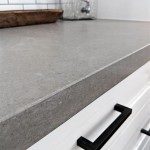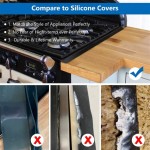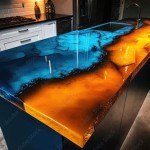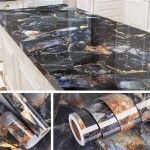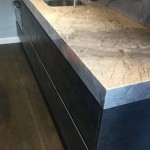White Quartz Countertops With Black Veins: A Comprehensive Guide
White quartz countertops with black veins have surged in popularity as a premier choice for kitchen and bathroom renovations. This aesthetic offers a compelling blend of timeless elegance and modern sophistication, providing a versatile surface that can complement a variety of design styles. Engineered from natural quartz crystals and resins, these countertops deliver a durable, low-maintenance alternative to natural stones like marble or granite.
The visual appeal of white quartz countertops with black veins lies in their ability to mimic the look of high-end natural materials while offering enhanced performance characteristics. The crisp white background serves as a canvas for the striking black veining, creating a dynamic and visually interesting surface. The veining patterns can range from subtle, delicate lines to bold, dramatic strokes, offering homeowners a range of aesthetic options to choose from. This adaptability makes them a suitable choice for a multitude of design schemes, including minimalist, contemporary, farmhouse, and even traditional.
Exploring the nuances of white quartz with black veins requires an understanding of its composition, manufacturing process, types, benefits, and maintenance requirements. This article aims to provide a comprehensive overview of this increasingly sought-after countertop material.
Composition and Manufacturing Process
Quartz countertops are engineered materials, meaning they are manufactured rather than extracted in their finished form directly from nature. The primary constituent of a quartz countertop is natural quartz, which comprises approximately 90-94% of the material by weight. This quartz is mined and then ground into various sizes, ranging from fine powders to larger aggregates. The remaining 6-10% consists of resins, pigments, and occasionally glass or metallic flecks, all of which contribute to the countertop's color, pattern, and overall aesthetic.
The manufacturing process begins with mixing the ground quartz with resins and pigments. The resins act as a binding agent, holding the quartz particles together and providing the countertop with its non-porous quality. Pigments are added to achieve the desired base color, in this case, white. To create the black veining effect, specialized techniques are employed. These techniques often involve precisely injecting or layering black pigment mixtures into the white quartz blend before the material is fully cured. The specific method used to create the veining affects the pattern's complexity, density, and overall appearance.
Once the mixture is prepared, it is poured into molds or spread onto a continuous belt system. Vibration and compression are then applied to compact the mixture, removing air pockets and creating a dense, solid slab. The slab is then cured or hardened, typically through a heating process. This curing process strengthens the resins, bonding the quartz particles together permanently. After curing, the slab is calibrated and polished to achieve a smooth, even surface. Finally, the edges are finished according to the desired profile, such as bullnose, eased, or beveled.
The engineered nature of quartz allows for a high degree of control over the color, pattern, and performance characteristics of the countertop, resulting in a consistent and reliable product.
Types of White Quartz Countertops with Black Veins
Within the category of white quartz countertops with black veins, there exists a considerable variety in terms of veining patterns, base colors, and finishes. Understanding these variations is crucial for selecting the ideal countertop for a specific design project.
Veining Patterns: The veining in white quartz countertops can range from subtle, delicate lines that resemble marble to bold, dramatic patterns that mimic the look of exotic natural stones. Some countertops feature thin, scattered veins that create a soft, understated look, while others have thick, prominent veins that make a strong visual statement. The density and complexity of the veining also vary significantly. Some patterns have a uniform distribution of veins, while others feature concentrated areas of veining that create a more dynamic and irregular appearance.
Base Colors: While the dominant color is white, subtle variations exist within the white spectrum of white quartz countertops. Some are a bright, pure white, while others have a slightly warmer or cooler undertone. Some may have a subtle gray or cream hue, which affects how the countertop interacts with the surrounding colors in the room. The choice of white tone can significantly impact the overall aesthetic of the kitchen or bathroom.
Finishes: The most common finish for white quartz countertops with black veins is polished, which provides a smooth, glossy surface that is easy to clean and maintain. However, other finishes are also available, such as honed or matte. Honed finishes have a softer, less reflective surface that creates a more subtle and understated look. Textures are becoming more available, offering even more design choices. The choice of finish can affect the countertop's appearance and its resistance to stains and scratches.
Brand Variations: Different manufacturers offer their own interpretations of white quartz with black veins, each with unique characteristics and aesthetic features. Some brands specialize in creating countertops that closely resemble specific types of marble, while others focus on developing innovative and original designs and complex patterns. Considering the brand and its reputation for quality and consistency is important when selecting a white quartz countertop with black veins.
These variations allow homeowners and designers to select a countertop that perfectly complements their design vision and meets their specific needs and preferences.
Benefits and Considerations
White quartz countertops with black veins offer a compelling combination of aesthetic appeal and practical advantages. However, like any material, it is important to consider the potential drawbacks before making a decision.
Durability: Quartz is one of the hardest natural minerals, making quartz countertops exceptionally durable and resistant to scratches, chips, and stains. The non-porous surface prevents liquids and bacteria from penetrating the material, making it hygienic and easy to clean. This durability ensures that the countertop will maintain its appearance and integrity for many years with minimal maintenance.
Low Maintenance: Unlike natural stones, quartz countertops do not require sealing or polishing. Regular cleaning with a mild soap and water is typically sufficient to keep them looking their best. The non-porous surface also makes them resistant to staining from common household liquids such as coffee, wine, and juice.
Consistency: As an engineered material, quartz offers a high degree of consistency in color and pattern. This consistency makes it easier to match multiple slabs and ensure a uniform appearance throughout the kitchen or bathroom. While natural stone can have significant variations in color and veining, quartz provides a reliable and predictable aesthetic.
Design Versatility: White quartz countertops with black veins are adaptable to a wide range of design styles. They can be used in both modern and traditional kitchens, and they complement a variety of cabinet colors and hardware finishes. The neutral color palette and striking veining create a focal point in the room while remaining versatile enough to blend seamlessly with other design elements.
Cost: Quartz countertops typically cost more than laminate or tile countertops, but they are often more affordable than high-end natural stones like marble. The long-term value of quartz, due to its durability and low maintenance, can make it a cost-effective investment over time.
Heat Resistance: While quartz is heat resistant, it is not entirely heatproof. Prolonged exposure to high heat can damage the surface, so it is important to use trivets or hot pads under hot pots and pans. Sudden temperature changes also can cause damage.
Seams: Depending on the size and layout of the kitchen, seams may be necessary when installing quartz countertops. While seams can be minimized, they are still visible and may affect the overall aesthetic of the countertop. The visibility of the seams can vary depending on the color and pattern of the quartz, as well as the skill of the installer.
Weighing these benefits and considerations carefully is essential for determining whether white quartz countertops with black veins are the right choice for a particular project and budget.

Countertop Materials

Kitchen Polished Modern Black Veins White Quartz Stone From China Stonecontact Com

Polished Calacatta White With Black Veins Surface Artificial Engineered Man Made Quartz Stone Slabs In China Com

Calacatta Quartz With Black Veins For Kitchens Gq T131

Black Veins Calacatta White Quartz Tables And Countertops From China Stonecontact Com

Quartz White With Black Veins Esta Stone

Calacatta Quartz Surface With Black Veins Stone Factory Suppliers Excellentstone Com

Black Vein Calacatta Quartz Suppliers Manufacturers Factory Whole Service Tingida

Stone Veining A Comprehensive Guide Lesher Marble

Prime Quartz Supplier Black Vein Calacatta White Available Customized Countertop Sizes Suppliers Optstone Com
See Also


